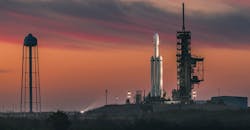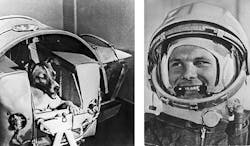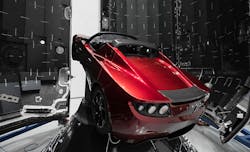Nowhere did Tuesday's launch of SpaceX's Falcon Heavy rocket echo as powerfully as in Russia. The private U.S. company continues to produce technical feats on which the Russian space industry has given up: First the consistent reuse of rockets, and now the successful launch of a rocket with as many as 27 engines.
The Soviet Union tried something similar in the 1960s and early 1970s. Sergei Korolev, the rocket designer who launched the first satellite and the first man into space, began the development of what came to be known as the N-1, a 30-engine superheavy rocket capable of taking a 75-ton space station to orbit and perhaps to the Moon, Mars, and Venus.
Finished after Korolev's death in 1966, the N-1 was test-launched four times. Each of the launches failed, largely because of the difficulty of running so many engines at the same time.
Now SpaceX has pulled off a similar task, and even though it's not clear yet who will contract for the Falcon Heavy's services, SpaceX founder Elon Musk now has the most capable missile in the world: It can deliver up to 64 tons into orbit.
Russia's plans to build such a rocket, capable of flying to the Moon or to Mars, aren't even complete yet, and certainly not fully funded, though Igor Komarov, head of Roskosmos, the Russian space agency, has promised the first launch in 2028. Even China is likely to have a superheavy launch vehicle before Russia. But it's the success of upstart Musk that smarts.
Roskosmos has the full power of the state behind it, after all. And yet here's this boyish-looking showman launching his roadster into space, David Bowie blasting from the car's speakers and "Don't Panic" — a quote from Douglas Adams' "The Hitchhiker's Guide to the Galaxy" — lit up on the central console.
First, the USSR sent the first dog, Laika, into space. Then cosmonaut Yuri Gagarin became the first human in space. Not many firsts since then.
Ever since the Soviet Union's collapse, the Russian space program has been run pragmatically for cash. Using time-tested technology, Russia seized leadership in the commercial launch market. But SpaceX's persistence and ingenuity, and its success in bringing down costs by reusing rockets, made it the likely market leader last year and possibly even profitable. The Falcon 9 was certainly the most successfully-launched rocket in the world.
Roskosmos has acknowledged the SpaceX threat, which it spent years pooh-poohing, and is working to reduce launch costs by 20% and reuse rocket components. But Musk's company is ahead of the game for now, and it won't be easy to catch.
Many Russians who are jealous of Musk's success point out that he hasn't gotten where he is without government support—technical assistance from NASA as well as billions in government subsidies. But the rest of the U.S. aerospace industry gets lots of government money, too, and so do European, Chinese, Japanese, and Indian space programs.
Egorov probably put his finger on the difference. The private passion of a socially clumsy, irritating, science fiction-reading, electric roadster-driving geek has done more to establish SpaceX's leadership than any state support could have done. The dream behind the engineering and the enterprise may not look as serious as the state considerations of Rogozin and Komarov—but it sure helps propel some heavy objects into space.
About the Author

Leonid Bershidsky
Leonid Bershidsky is a member of the Bloomberg News Automation team based in Berlin. He was previously Bloomberg Opinion's Europe columnist. He recently authored a Russian translation of George Orwell's "1984."


